Abstract
As China’s largest peninsula, the Shandong Peninsula faces recurrent threats from both tropical and extratropical cyclone-induced storm surges. Understanding the distinct mechanisms governing these surge types is critical for developing targeted coastal hazard mitigation strategies. This investigation employs the FVCOM-SWAVE coupled wave–current model to conduct numerical simulations and comparative analyses of two 2022 surge events, Typhoon Muifa (tropical) and the “221003” extratropical surge. The results demonstrate that hydrodynamic responses exhibit strong dependence on surge-generating meteorological regimes. Tropical surge dynamics correlate closely with typhoon track geometry, intensity gradients, and asymmetric wind field structures, manifesting rightward-biased energy intensification relative to storm motion. Conversely, extratropical surge variations align with evolving wind-pressure configurations during cold air advection, driven by synoptic-scale atmospheric reorganization. The hydrodynamic environmental response in the sea areas surrounding Jiaodong and Laizhou Bay is particularly pronounced, influenced by the intensity of wind stress on the sea surface, as well as the bathymetry and coastal geometry.
1. Introduction
Storm surge, defined as an abnormal sea-level fluctuation induced by severe meteorological disturbances (principally extreme winds and rapid barometric pressure variations), represents a critical coastal hazard that is categorized into tropical and extratropical types [1]. Tropical storm surges, generated by intense cyclonic systems, including typhoons and hurricanes, predominantly manifest in mid- to low-latitude coastal regions in summer and autumn. These events frequently exhibit catastrophic destruction and constitute one of the most severe marine disasters affecting global subtropical and tropical coastlines. In contrast, temperate storm surges, typically associated with extratropical cyclones and cold-air outbreaks, demonstrate more gradual water level variations, occasionally accompanied by negative surge. These phenomena primarily occur in mid–high-latitude zones during transitional seasons (spring and autumn), presenting lower magnitude impacts than their tropical counterparts [2].
As China’s largest peninsula, the Shandong Peninsula exhibits distinct storm surge occurrence characteristics, and its eastern and southern coasts are particularly vulnerable to tropical cyclone-induced typhoon surges from the northwest Pacific, whereas northern areas, including Laizhou Bay, experience higher exposure to extratropical storm surge systems [3]. Advancements in computational modeling have enabled systematic investigation of the storm surge dynamics of Shandong. Li et al. [4] implemented a coupled WRF-ROMS atmosphere–ocean model to comparatively analyze surface wind and current field evolution during two distinct extreme weather events in the Bohai Sea. Through numerical simulations of historical surge events (1985–2017), Du et al. [5] quantified the spatiotemporal patterns of water level anomalies and significant wave height variations across three major marine ranchings adjacent to the Shandong Peninsula. Li et al. [6] conducted sensitivity analyses on wind stress drag coefficient parameterizations and evaluated their impacts on typhoon surge simulation accuracy in the North China Sea under both wave-coupled and wave-uncoupled scenarios. Xu et al. [7] developed a three-dimensional typhoon surge model for the North Yellow Sea and Bohai Sea using the FVCOM-SWAVE, demonstrating that bidirectional wave–current coupling significantly improves simulation accuracy compared to uncoupled scenarios through validation against observational datasets. Their comparative analysis revealed enhanced consistency between the modeled and measured surge parameters under coupled conditions. Mo et al. [8] conducted sensitivity analyses of water level variability, current field dynamics, and significant wave height responses to nonlinear wave–current interactions during cold-air outbreaks in the northern East China Sea and Bohai-Yellow Sea systems, and the results show that the storm water level change triggered by wave action in the shallow water area is significantly larger than that in the central deep-water area of the East, Yellow, and Bohai Seas.
While existing research has predominantly focused on the generation mechanisms and water level anomalies of individual storm surge events along the Shandong coast, comparative analyses between tropical and extratropical surge types remain scarce. We implemented a three-dimensional real-time coupled model with bidirectional wave–current interactions using FVCOM-SWAVE and selected two representative events for systematic comparison: Typhoon Muifa (September 2022) as a tropical surge storm and the 221003 cold-air outbreak (October 2022) as an extratropical surge storm. Through high-resolution numerical simulations, we contrastingly analyzed the differential responses in sea surface elevation, sea current fields, and significant wave height evolution patterns between these meteorologically distinct storm types. These results provide critical insights for refining predictive models of marine hydrodynamics and enhancing operational storm surge warning systems along the coastline of Shandong.
2. Numerical Models
2.1. Holland-ERA5
The parametric empirical wind field demonstrates superior accuracy in typhoon core regions, whereas the background wind field provides more reliable simulations in peripheral zones beyond the radius of the maximum winds [9]. To leverage these complementary strengths, we used a hybrid methodology integrating both wind fields to generate the forcing wind field of the model. The background component was derived from the European Center for Medium-Range Weather Forecasts (ECMWF) ERA5 reanalysis dataset “https://www.ecmwf.int (accessed on 15 March 2025)”, featuring a 0.25° × 0.25° spatial resolution, hourly temporal resolution, and 10 m elevation above the mean sea level.
The empirical wind field was simulated using the Holland model [10], which incorporates the radial pressure distribution parameter B (dimensionless shape coefficient) scaled by the radius of maximum wind (Rmax) to optimize the barometric profile configuration with fewer calibrated parameters. The model’s governing equations defining the pressure field and gradient wind velocity are expressed as:
where represents the atmospheric pressure at a distance r from the typhoon center, denotes the gradient wind speed at the radial distance of r, and correspond to the central and peripheral atmospheric pressures of the typhoon ( sets at 1010 hPa), Rmax signifies the radius of the maximum wind speed, B is the radial pressure distribution parameter, r is the distance from the calculation point to the center of the typhoon, is the air density (the value is 1.2 kg/m3) and f represents the Coriolis parameter.
Among them, there are several different empirical formulas for the maximum typhoon wind radius Rmax, and Willoughby’s formula [11] is used here, as follows:
where φ represents the latitude of the typhoon center, denotes the maximum wind speed.
The hybrid wind-field synthesis employed a radial distance-dependent weighting coefficient e to dynamically blend the Holland parametric wind field with the ERA5 reanalysis wind field. This blending scheme prioritizes the Holland gradient wind representation in the typhoon core region (r < 2Rmax) and transitions to ERA5 dominance in the peripheral zones (r ≥ 2Rmax). The distance-weighted coefficient ensures a smooth transitional behavior between the two datasets while maintaining physical realism in the synthesized wind field [12]. The governing formulation for this wind-field fusion is expressed as [9]:
where represents the composite wind field, denotes the empirical wind field derived from the Holland model, signifies the ERA5 background wind field, is a weighting coefficient, defined as , where the coefficient , and n is assigned a value of nine.
The radial pressure distribution parameter B in the Holland model critically modulates the typhoon intensity metrics and wind field structure. Under controlled conditions with a fixed central pressure () and radius of maximum winds (Rmax), sensitivity analyses revealed that elevated B values produced progressively steeper wind speed profiles (Figure 1). This steepening gradient manifests as intensified barotropic pressure differentials between the typhoon core and transitional zone, particularly enhancing the wind speed variability of the storm center in blended wind field simulations.
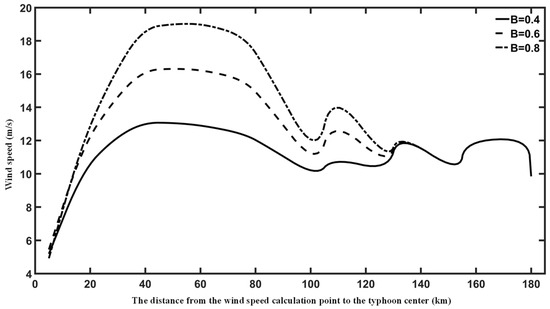
Figure 1.
Wind speed profile of typhoon with different Holland B.
Comparisons between hybrid wind field simulations and in situ anemometer measurements at Xiaomai Island (XMD) and Zhifu Island (ZFD) demonstrated different capabilities in capturing dynamic wind speed/direction variations under varying parameter B configurations (Figure 2). Calibration at B = 0.4 achieved optimal alignment with observed wind speeds (RMSE < 4.0 m/s) while maintaining directional consistency (mean angular deviation < 35°). However, early-phase typhoon simulations exhibited systematic overestimation, particularly at the XMD station, where the blended wind speeds exceeded the measurements. This discrepancy stems from inherent limitations in the capacity of the Holland model to replicate the asymmetric wind structure characteristics of real-world typhoons, which often generate intensified peripheral flows [12].
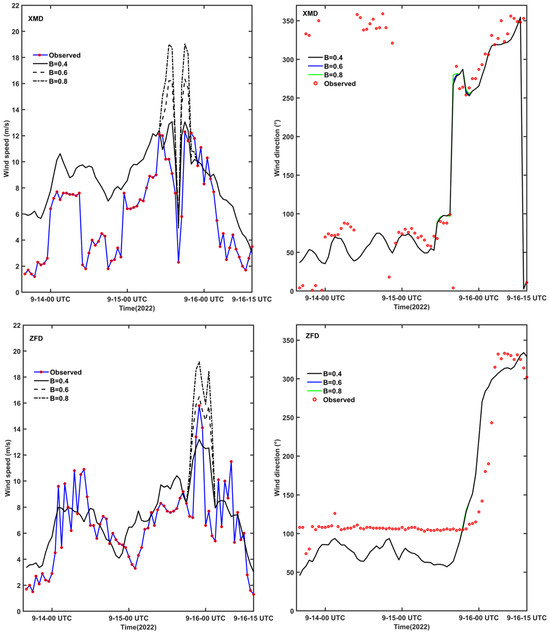
Figure 2.
Comparison between Holland-ERA5 wind and observed wind with different Holland B.
2.2. FVCOM-SWAVE
The Finite Volume Coastal Ocean Model (FVCOM), initially developed by Chen et al. [13], employs a finite volume discretization scheme to solve three-dimensional primitive hydrodynamic equations on unstructured triangular meshes. Subsequent advancements by Qi et al. [14] integrated spectral wave dynamics through the FVCOM-SWAVE module, which adapted the third-generation SWAN wave model to FVCOM’s unstructured grid architecture. This coupled system maintains horizontal grid consistency between the hydrodynamic and wave modules, achieving real-time bidirectional coupling via shared-memory variable exchange. Key wave parameters calculated after model initialization, including the significant wave height (HS), wavelength (L), peak spectral period (Tp), and radiation stress components (, , ), are dynamically transferred from SWAVE to FVCOM. Concurrently, the hydrodynamic outputs (current velocity u and sea surface elevation η) were synchronized back to the wave module. These coupled fields jointly inform the bottom boundary layer model, where iterative calculation of the bed shear stress (τb) occurs until the hydrodynamic convergence criteria are met [15]. The governing equations incorporating wave–current interactions in σ-coordinates are formulated as follows:
where D = H + η is the total water depth, H is the static water depth, η is the undulating height of the sea surface, u, v and w are the velocity components in x, y and σ directions, t is time, f represents the Coriolis parameter, g is the acceleration of gravity, is the atmospheric pressure on the sea surface, is the vertical eddy viscosity coefficient, , are horizontal momentum diffusion terms, , are the reference density and the total density of seawater. Because the difference in seawater density is not considered in this study, . , , are the horizontal wave radiation stress terms.
3. Model Setup
The 2022 “221003” extratropical storm surge event inflicted direct economic losses of RMB 1.198 billion in Shandong Province, representing 50.35% of China’s total storm surge-related damages that year. And the severe Typhoon Muifa (international designation: 2212) caused provincial losses exceeding RMB 67 million through its tropical surge impacts [16]. It is clear that the 2022 co-occurrence of tropical and extratropical storm surges inflicted substantial socioeconomic impacts across Shandong’s coastal urban areas. A comparative analysis of these meteorologically distinct surge types provides critical insights for optimizing coastal defense strategies, enhancing real-time emergency response protocols, and refining risk assessment frameworks in cyclone-prone regions. Therefore, given factors such as the occurrence time, scope of action, and intensity of the disasters, these events were selected as archetypal cases for comparative analysis: (1) Typhoon Muifa (14–16 September 2022), exemplifying tropical cyclone-induced surges, and (2) Cold-Air Outbreak 221003 (3–5 October 2022), representing extratropical surge mechanisms.
The Typhoon Storm Surge Model (TSSM) and Extratropical Storm Surge Model (ESSM) were constructed using the Surface Water Model System (SMS) with the Global Self-Consistent, Hierarchical, High-Resolution Geography (GSHHG) dataset to generate horizontally unstructured triangular grids (Figure 3). The computational domain spans 117–129° E and 30–41° N, employing σ-coordinates vertically with nine layers. Open boundaries were positioned 750 km beyond the study area to adequately resolve the surge generation and propagation dynamics. Bathymetric inputs adopted the General Bathymetric Chart of the Oceans (GEBCO_2023) “https://www.gebco.net (accessed on 15 March 2025)” 15-arcsecond grid (IHO/IOC standard) and high-resolution electronic navigational charts (ENCs) for nearshore zones (<80 m depth), all of which referenced the mean sea level. The bottom friction was parameterized using a quadratic drag coefficient (Cd = 0.0012). Table 1 summarizes the critical TSSM/ESSM configuration parameters, including mesh resolution, time step, and run duration.
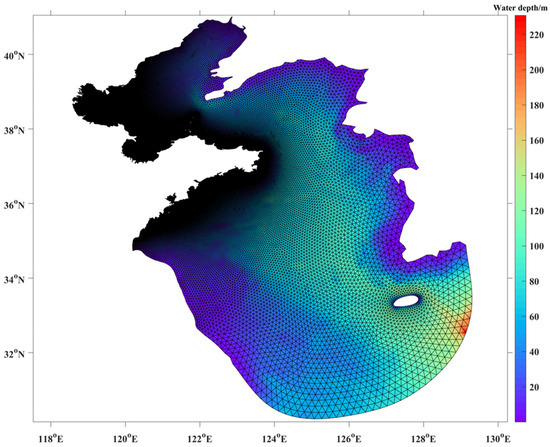
Figure 3.
Model grid and simulation domain.

Table 1.
Parameter configuration in the model.
The tide level validation data are from the measured water level data of six tide gauge stations: Qingdao (QD), Longkou (LK), Tanggu (TG), Huanghua harbor (HHG), Rizhao harbor (RZG), and Weifang harbor (WFG). The validation data of tidal current, effective wave height, and wind speed were obtained from the National Ocean Science Data Center “https://mds.nmdis.org.cn (accessed on 15 March 2025)”, a national platform for sharing scientific and technological resources, of which the current flow data were the tidal current prediction results of the three stations, namely, Bohai Sea Route (C1), Chengshanjiao (C2), and Laotieshan Waterway (C3). The significant wave height data were the measured data from Xiaomai Island (XMD), and the wind speed measurement stations were the two stations from Xiaomai Island (XMD) and Zhifudao Island (ZFD). The locations of these stations are shown in Figure 4.
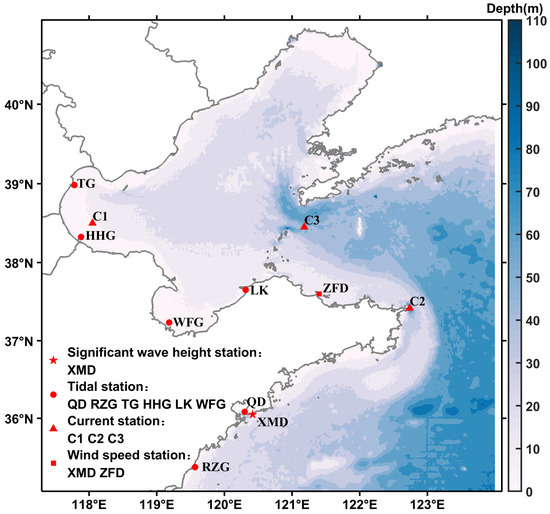
Figure 4.
Location of observation stations along the coast of Shandong.
The evaluation coefficient S [17,18,19] and root mean square error R were used to describe the degree of model accuracy using the following formula:
where n is the total number of samples for the corresponding variable, Xmod and Xobs are the simulated and measured values, respectively, and is the average value of the measured variables. The value range of S is [0, 1]; 0 indicates that the simulated value is completely inconsistent with the measured value, and 1 indicates that the simulated value is completely consistent with the measured value.
4. Results
4.1. 2212 Typhoon Storm Surge
Typhoon Muifa’s track was obtained from the China Meteorological Administration’s (CMA) Tropical Cyclone Best Track Dataset [20,21], with the genesis occurring at 21.5° N, 136.7° E [22] in the western North Pacific (Figure 5a). The system made landfall as a tropical storm (TS) at Laoshan, Qingdao (36.15° N, 120.65° E), on 16 September 2022, at 0000 UTC (0800 Beijing Time), featuring a central pressure of 990 hPa and a maximum sustained wind speed of 23 m/s (Beaufort Force 9). During its Shandong coastal transit (15 September 0800-1600 UTC), the storm induced a steepened pressure gradient, generating 8–10 Beaufort scale gusts (17–24 m/s) and localized precipitation exceeding 150 mm. The system continuously propagated northeastward, with cyclonic energy concentrated over the Bohai Sea (37.0–41.0° N, 118.7–122.3° E). By 0400 UTC on 16 September, it had again made landfall in Liaoning (39.6° N, 122.5° E) and was gradually weakening (Figure 5b–f). Wind vectors (10 m elevation, black arrows) and isobars (red contours) illustrate evolving synoptic patterns.
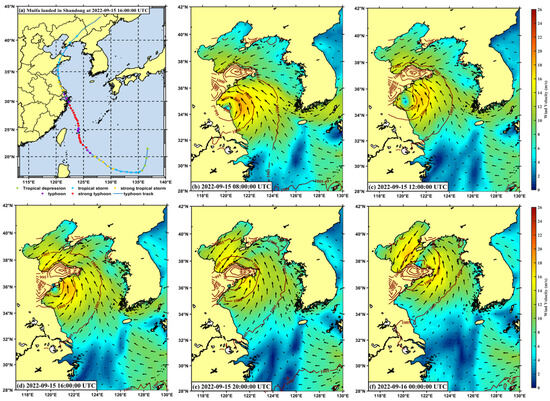
Figure 5.
Best track of Typhoon Muifa (a) and spatial distribution of the wind and pressure filed (ERA-5) during Muifa passing through Shandong (b–f).
The Typhoon Storm Surge Model (TSSM) was validated by comparing the hourly simulated and observed total water levels, current velocities and directions, significant wave heights (HS), and wind speeds across the monitoring stations (Figure 6). Typhoon storm tide simulations demonstrated strong agreement with observations at six tide gauges (S > 0.93), although phase deviations led to a 1 h lead in tidal predictions at Qingdao (QD) and Rizhao (RZG). Current velocity root mean square errors (R) remained ≤ 0.15 m/s across stations, with directional variations maintaining coherence. At Xiaomai Island (XMD), HS simulations accurately replicated the observed rapid growth-slow decay pattern, achieving S = 0.98 and R = 0.26 m. The full validation metrics (S and R) for all parameters are systematically tabulated in Table 2, delineating the model performance across hydrodynamic variables.
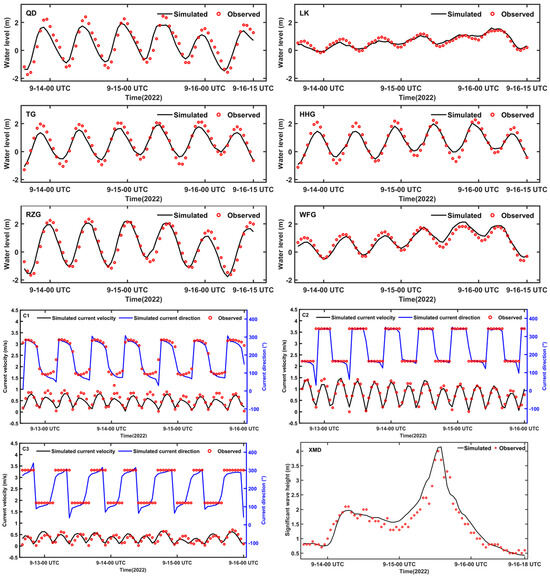
Figure 6.
Verification of water level, current velocity, current direction, and significant wave height of TSSM.

Table 2.
Error analysis of simulation results of TSSM.
Typhoon-induced storm surges exhibited significant amplification along the Shandong Peninsula, particularly along the southwestern coastline and Laizhou Bay (Figure 7). During the pre-landfall phase (8 h prior to landfall), maximum surge amplitudes (~1.0 m) developed seaward of the Rizhao-Qingdao coastal zone, corresponding to the typhoon’s radius of maximum wind over the sea. The surge intensity subsequently decayed as the translational speed of the typhoon decreased. Concurrently, Laizhou Bay experienced a progressive water level rise during the typhoon’s northward trajectory, culminating in a 1.3 m surge at landfall (Figure 7d). Following the typhoon’s northward migration into the Bohai-Yellow Sea confluence, persistent northerly winds (orthogonal to the shoreline) drove a substantial seawater influx into southern Laizhou Bay. This wind-forced setup interacted synergistically with the bay’s concave coastal morphology and gradual bathymetric gradient, resulting in resonant water accumulation at the bayhead. The combined wind-topography forcing ultimately generated a maximum surge of 1.4 m at the WFG station at the top of Laizhou Bay (Figure 7f).
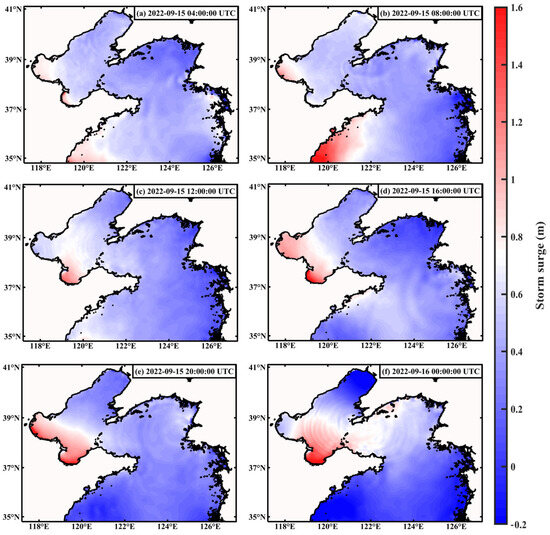
Figure 7.
Spatial distribution of storm surge calculated by TSSM. (a–f) show the storm surge at four-hour intervals from 15 September 2022, 0400 UTC to 16 September 2022, 0000 UTC. ‘Storm surge’ is the total water gain from the modeled total water levels minus the modeled astronomical tide levels.
During typhoon transit, the sea surface current fields are governed by the synergistic effects of astronomical tides, typhoon wind stress, and bathymetric constraints. During the pre-landfall phase, southeasterly winds perpendicular to the shoreline dominated the south-eastern Shandong coastal region (Figure 5). As the typhoon center migrated northward, wind-driven surface currents developed pronounced cyclonic circulation patterns, with directional shifts from wind-aligned flows to counterclockwise rotations centered on the typhoon eye (Figure 8a,b). Upon landfall at Qingdao, current field trajectories radiated asymmetrically from Jiaozhou Bay, exhibiting enhanced flow velocities (>0.8 m/s) along the typhoon’s right-front with distinct cyclonic shear characteristics (Figure 8c,d). This asymmetric cyclonic structure persisted through the typhoon’s northward propagation across Shandong, gradually dissipating only after the Liaoning landfall at 0400 UTC on 16 September (Figure 8e,f). Wind stress amplification during surge conditions elevated nearshore current magnitudes to approximately 1.0 m/s along critical coastal sectors.
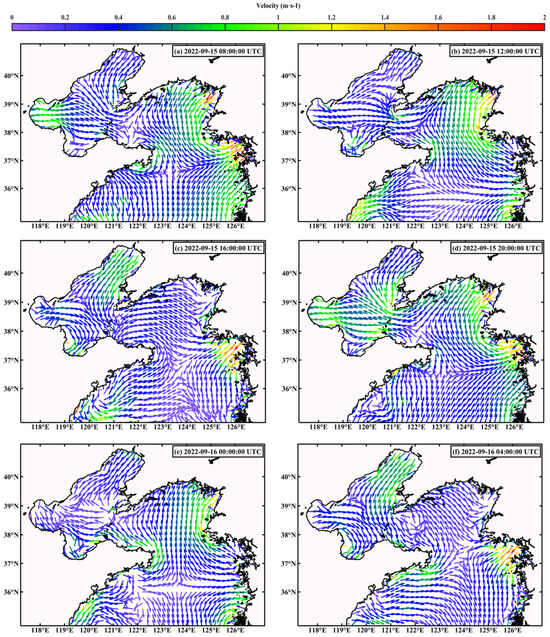
Figure 8.
Spatial distribution of sea surface current field calculated by TSSM (interval of 4 h). (a–f) show the sea surface current field at four-hour intervals from 15 September 2022, 0800 UTC to 16 September 2022, 0400 UTC.
The spatial distribution of the significant wave heights (HS) around the Shandong Peninsula exhibited a strong correlation with the radius of the typhoon’s maximum winds. As Typhoon Meihua propagated northward through the South Yellow Sea, the HS magnitudes increased progressively, displaying rightward-biased asymmetry relative to the storm track (Figure 9). A persistent crescent-shaped zone of extreme waves (HS ≥ 8 m) developed near the Changmenyan and Chiyan Islands, maintaining quasi-stationary growth patterns. While deep-water wave energy typically concentrates nearshore owing to decreasing bathymetric gradients, subsequent irregularities in shoaling and coastal areas normally induce wave breaking and energy dissipation, causing rapid post-peak height reduction [5]. The anomalous maintenance of elevated HS near Chiyan Island suggests potential garden sprinkler effects (GSE) which require further investigation, including (1) insufficient spectral resolution for swell evolution modeling or (2) delayed wave breaking dynamics allowing paradoxical intensification. Post-typhoon conditions revealed contrasting trends: the southern coastal HS decreased markedly with wind relaxation, while the northern coasts (north of Shidao) experienced moderate wave reinforcement (HS ~3 m) due to residual energy propagation (Figure 9e,f).

Figure 9.
Spatial distribution of significant wave height calculated by TSSM (interval of 4 h). The red boxed areas in the corresponding subfigures above are zoomed in on the ranges shown in the lower subfigures (a–f).
4.2. 221003 Extratropical Storm Surge
From 2 to 4 October, a southward-propagating cold air mass originating from Siberia and Mongolia triggered a nationwide cold wave event, inducing temperature descent ranges exceeding 12 °C with 9–11 Beaufort scale northeast gales across the Bohai-Yellow Sea coastal zone [22,23]. This synoptic pattern generated severe extratropical storm surges along Bohai Bay, Laizhou Bay, and the northern coast of Shandong. Between 0000 and 1800 UTC on 3 October, the eastward-migrating East Asian trough transitioned from zonal to meridional orientation, driving sustained coastal pressure rises in Shandong accompanied by persistent 7–9 Beaufort northeast winds (gusting 9–11 Beaufort) (Figure 10).
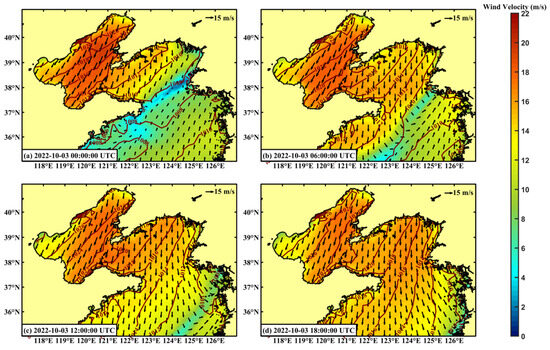
Figure 10.
Spatial distribution of the wind and pressure filed (ERA-5) during the “221003” extratropical storm surge process (a–d).
The Extratropical Storm Surge Model (ESSM) was validated by comparing the hourly simulated and observed total water levels, current velocities and directions, significant wave heights (HS), and wind speeds across the monitoring stations (Figure 11). Extratropical storm tide simulations showed strong agreement with observations at six tide gauges (S ≥ 0.93), although phase deviations led to a 1 h lead in tidal predictions at Qingdao (QD) and Rizhao (RZG). Current speed overestimations (R > 0.20 m/s) occurred at Station C3, with directional discrepancies during peak flow phases. From 0000 UTC 3 October to 0000 UTC 4 October, HS simulations exhibited systematic overestimations (R~0.25 m), potentially linked to ERA5 wind speed biases in the nearshore boundary layer. Comprehensive validation metrics (S and R) are quantified in Table 3, highlighting the parameter-specific model performance variations.
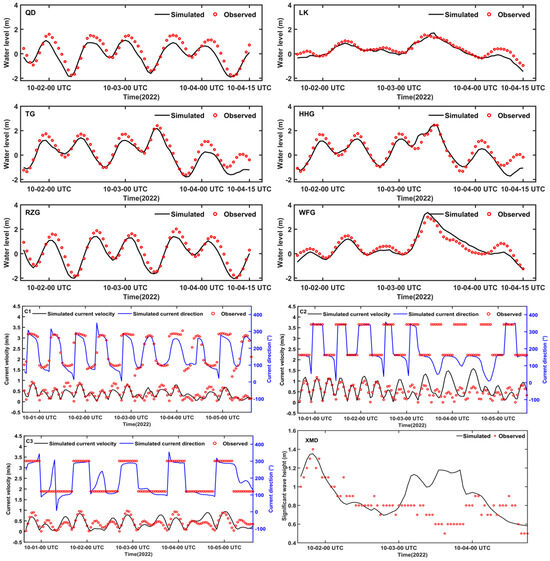
Figure 11.
Verification of water level, current velocity, current direction and significant wave height of ESSM.

Table 3.
Error analysis of simulation results of ESSM.
During the “221003” extratropical storm surge event, the most pronounced water level anomalies along the Shandong coast occurred in Laizhou Bay, attributable to its semi-enclosed geomorphology and bathymetric configuration (Figure 12). Northeast gales associated with the cold surge drove southward transport of Liaodong Bay surface waters, converging along the southern Bohai Sea coastline to generate 1.0–1.6 m surge elevations from Bohai Bay to Laizhou Bay. The maximum surge of 1.9 m recorded at Weifang Port coincided with astronomical high tides, inducing intensified hydrodynamic activity through combined wind stress, barometric forcing, and tidal amplification. Surge propagation exhibited temporal lag effects, with Laizhou Bay peak levels occurring 2–3 h later than Bohai Bay due to (1) southeastward migration of the atmospheric pressure system altering wind stress patterns, and (2) topographic retardation. The southern Shandong coast experienced attenuated surge impacts (<0.5 m) compared to northern sectors, demonstrating reduced vulnerability to extratropical surge penetration from a northern approach.
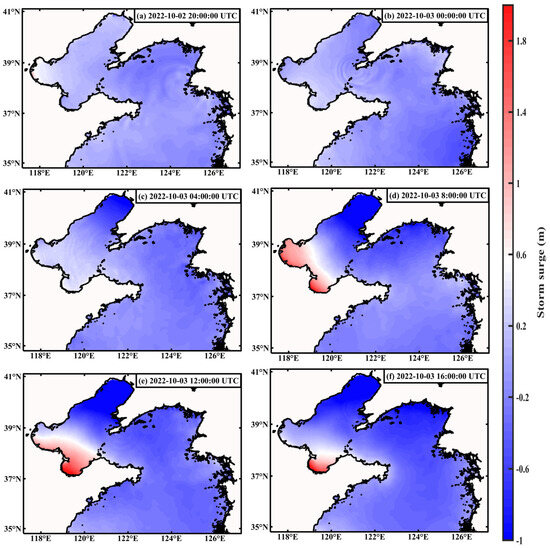
Figure 12.
Spatial distribution of storm surge calculated by ESSM (interval of 4 h). (a–f) show the storm surge at four-hour intervals from 2 October 2022, 2000 UTC to 3 October 2022, 1600 UTC. ‘Storm surge’ is the total water gain from the modeled total water levels minus the modeled astronomical tide levels.
The passage of cold waves induced intense wind-driven processes and significant barometric variations offshore Shandong, altering both water level dynamics and current field structures (Figure 13). The initial phase currents exhibited a complete flow reversal: Bohai Sea surface currents shifted from shoreward inflow to southward outflow through Liaodong Bay, with velocities reaching 0.8 m/s (peak > 1.0 m/s) (Figure 13a–d). The synoptic pressure transition from zonal to meridional trough orientation generated barotropic pressure gradients, driving seawater redistribution (Figure 13e,f). Concurrently, rapid thermal stratification from abrupt sea surface cooling modifies the vertical current shear. Southeastern Shandong waters exhibited weaker winds, resulting in minimal wind-driven currents and persistent dominance of western Yellow Sea tidal flows. ERA5 wind field limitations introduce directional biases in nearshore current simulations during peak wind events.
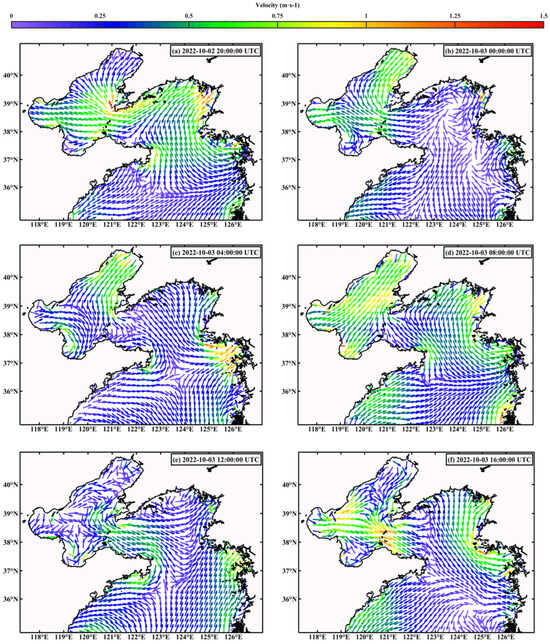
Figure 13.
Spatial distribution of sea surface current field calculated by ESSM (interval of 4 h). (a–f) show the sea surface current field at four-hour intervals from 2 October 2022, 2000 UTC to 3 October 2022, 1600 UTC.
Persistent northerly winds induced spatiotemporal variability in wave energy across the Bohai-Yellow Sea system, with significant wave height (HS) exhibiting a positive correlation with the wind speed magnitude (Figure 14). Wave intensification progressed southeastward following the trajectory of cold air. Under combined wind stress and barometric forcing, the HS of the Bohai Sea increased markedly, peaking at 5.0 m in the northern Laizhou Bay. Concurrent southeastward migration of the wind core enhanced the Yellow Sea wave activity, yielding HS values of 3–4 m in the northern sectors and 2–3 m in the southern regions. Bathymetry produced distinct nearshore–offshore gradients, with Shandong’s coastal shallows (<20 m depth) demonstrating 40–60% lower HS compared to adjacent deeper waters (>50 m depth), confirming the inverse proportionality between wave heights and proximity to the shoreline.
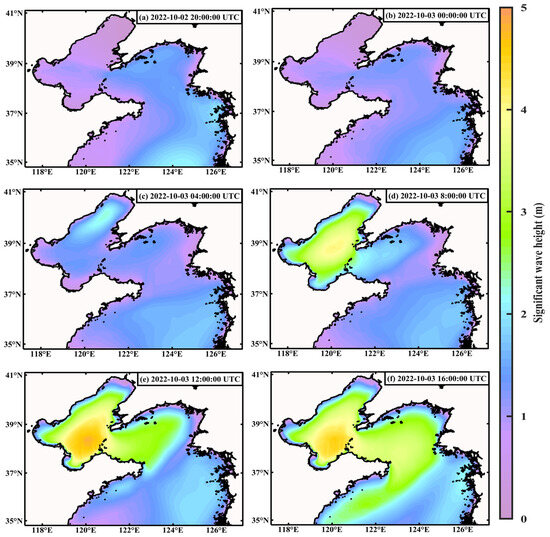
Figure 14.
Spatial distribution of significant wave height calculated by ESSM (interval of 4 h). (a–f) show the significant wave height at four-hour intervals from 2 October 2022, 2000 UTC to 3 October 2022, 1600 UTC.
5. Discussion
Significant disparities exist between tropical and extratropical storm surge wind fields in Shandong’s offshore waters, corresponding to distinct surge magnitudes and spatial ranges. Typhoon Muifa landed in Qingdao from south to north, resulting in a storm surge near the southwest coast of Shandong. Subsequently, the intensity of the typhoon did not weaken and continued to move forward, leading to a more serious water increase in northern Laizhou Bay. Conversely, the “221003” extratropical surge event produced no obvious water-level anomalies along the southwestern coast. Under the influence of wind stress, Laizhou Bay exhibited the most pronounced hydrodynamic responses, which were attributed to its unique bathymetric profile and coastal configuration. The maximal surge magnitudes in this bay zone aligned with earlier findings by Yu et al. [24], confirming regional vulnerability to both surge types. Typhoon and extratropical storm surges induce distinct surface current responses in Shandong’s offshore waters. Counterclockwise circulation develops around the typhoon core, while cold wave events maintain unidirectional current dominance in the Bohai Sea and Yellow Sea. This study advances prior research by comparing wave field responses to both surge types, revealing critical differences in significant wave height (HS) distributions. During typhoon passage, HS exhibits rightward-skewed asymmetry relative to the track of the typhoon, with maximum wave energy concentrated within the radius of maximum winds (RMW). Wave energy propagation shows strong spatial coupling with the typhoon trajectory from the central Yellow Sea through the Bohai Sea. Conversely, extratropical surges merely generate the most pronounced HS variations (>2.5 m) in deeper offshore zones (>50 m depth) of the North Yellow Sea, despite southerly cold air penetration steadily.
To examine the most critical characteristics of storm surges, this study concentrates on the variation patterns of storm surge elevation across two distinct types of storm surges. Both storm surge types exhibit analogous hydrodynamic signatures in the intensity of storm surge elevation; strong winds tend to bring large increases in water, wherein wind-driven surge magnitudes are amplified during astronomical high-tide phases, likely culminating in extreme water level anomalies. Coastal embayments with complex morphologies demonstrate heightened susceptibility to onshore wind-induced setups compared to open-ocean environments, leading to pronounced water level elevations through geomorphic amplification. Both regions exhibited a similarity in the extent of the sea area affected by water increase, both along northern Laizhou Bay. Following its landfall in Qingdao, Shandong Province, Typhoon Muifa progressed northeastward, traversing the entire Jiaodong Peninsula through its center. Consequently, the waters of Laizhou Bay, and even portions of Bohai Bay, fell within the radius of the typhoon’s maximum wind speed, resulting in significant disturbance of the surface seawater due to intense northward winds. Additionally, cold waves originating from the north and moving southward traversed Shandong, the entire Bohai Sea, and the northern Yellow Sea and were driven by persistent strong northerly winds. This phenomenon caused seawater to be displaced southward, with the Laizhou Bay waters being the most affected. In addition, the difference between the two is that the typhoon storm surge also affected Qingdao, Rizhao, and other coastal cities on the southwest coast, the surrounding waters in Typhoon Muifa from south to north gradually approaching Shandong and landing in Qingdao during the existence of a significant rise in water level. The reason for this cannot be separated from the direction of movement of the typhoon and the landing location. Stormwater increase did not occur in these areas during the cold wave, which is considered to be related to the special geographic location and shoreline morphology of the Shandong Peninsula. Owing to blockage by the landmass of the Jiaodong Peninsula extending seaward, the winds at sea were weakened, and the wind direction was almost parallel to the southwest coast, which made it easier to blow coastal seawater away from the sea. From the point of view of the time sequence of the occurrence of storm surge, in the process of a typhoon, when the sea approaches the maximum wind speed radius, the storm surge phenomenon also gradually begins to appear. Cold wave cold air has unique barometric pressure–trough characteristics. When the barometric pressure field gradually moved from horizontal to vertical, the scope of action of the wind stress gradually moved southeast. The original strong wind area affecting northwestern Bohai Bay gradually acted over Laizhou Bay, thus leading to a time difference in the occurrence of storm surges. From the above perspectives, the main factors affecting the degree of water augmentation in different types of storm surges were the strength and structure of the wind field.
This study acknowledges the limitations in elucidating the mechanistic differences in water level anomalies between tropical and extratropical storm surges. Nearshore surge dynamics inherently involve complex wave–current–tide interactions, where water-level fluctuations represent the synergistic effects of multiple forcing agents, often incorporating storm surge, wave surge, and water-level changes due to astronomical tide-storm surge nonlinear interactions. Previous investigations employing diverse methodologies have advanced our understanding of surge mechanisms, and Ignacio et al. [25] quantified the relative contributions of atmospheric pressure gradients and wind stress to surge variability along Spain’s heterogeneous coastline. You et al. [26] statistically analyzed long-term water level data and found that significant astronomical tide-storm surge nonlinear interactions exist in estuaries and bays where the water depth is shallow and the tidal power is strong. Therefore, sensitivity tests can be further developed around different driving factors to consider the mechanisms of wind stress, barotropic gradient force, wave–current interaction, and astronomical tide–storm surge nonlinear interaction on the water-enhancing effects of the two types of storm surges offshore Shandong. At the moment of the maximum water increase caused by the two types of storm surges, the wave field, barometric pressure field, and wind field in the study area are also characterized by a very high concentration of energy (Figure 15), but now it is impossible to directly extract information on the amount of water increase caused by each driving factor and the contribution rate to the extreme value of water increase. Therefore, a subsequent quantitative comparison of the water increase caused by each influencing factor by strictly controlling the driving field variables is conducive to further improving the understanding of the mechanism of the two types of storm surge water increase along the Shandong coast. At the same time, the sample size of the actual tide gauge stations used to validate the storm surge model in this study was relatively small, which does not fully cover the wide range of the neighboring sea area of the Shandong Peninsula, and thus may have overlooked the details of the wave changes in a short period of time in some sections. In the future, we should focus on collecting more tide gauge stations to improve the reliability of the simulation data.
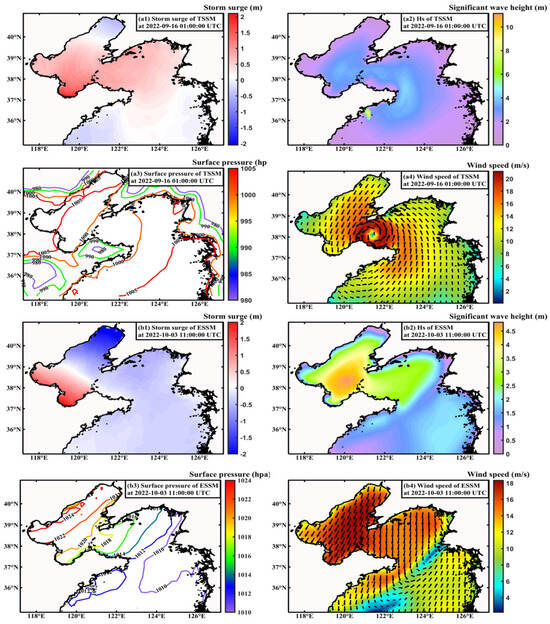
Figure 15.
Spatial distribution of maximum storm surge, significant wave height, pressure, and wind field ((a1–a4): TSSM; (b1–b4): ESSM).
6. Conclusions
This study built a coupled storm surge modeling system for the Shandong Peninsula, successfully simulating two distinct events: the tropical cyclone Muifa (2212) and the “221003” extratropical surge. The TSSM simulations demonstrate that the total water level anomalies, surface currents, and significant wave height (HS) distributions exhibit strong dependence on typhoon trajectory, wind field morphology, and wind intensity, with characteristic right-biased energy asymmetry relative to the typhoon track. For extratropical surge scenarios (ESSM), hydrodynamic parameter variations align closely with evolving wind/pressure field configurations during cold air advection.
As a leading maritime province in China, Shandong experiences annual storm surge events, with extratropical surges constituting the predominant type in both frequency and socioeconomic impacts. This study investigated two 2022 events: the economically devastating “221003” extratropical surge and tropical cyclone Muifa’s impact. Given the rarity of direct typhoon landfalls in Shandong (only two occurrences between 2013 and 2022: Lekima (2019) and Muifa (2022)), these findings provide critical insights into tropical surge mechanisms within temperate zones, informing localized disaster mitigation strategies. Comparative analyses revealed Laizhou Bay’s heightened vulnerability to both surge types, particularly Weifang City at the bay’s apex, corroborating prior studies on coastal geomorphic susceptibility. Wave dynamics analyses demonstrated that while storm-induced water level anomalies correlated with wave radiation stress, nearshore shoaling processes significantly attenuated wave energy contributions (generally <15% of the total setup), suggesting that wave forcing plays a secondary role in surge amplification during extreme events.
Although this work elucidates the key hydrodynamic responses of the Shandong coastal system to both surge types, critical limitations persist. Future efforts should prioritize enhancing wave-tide-current coupling fidelity, resolving spectral energy propagation deficiencies in Hs simulations, and implementing controlled sensitivity experiments to quantify the individual forcing contributions. These refinements will advance the predictive capabilities of compound meteorological–hydrodynamic interactions in Shandong coastal systems.
Author Contributions
Conceptualization, Z.W., J.Z. and W.L.; supervision, Z.W. and J.Z.; writing—original draft, W.L.; writing—review and editing, W.L. and Q.Z. All authors have read and agreed to the published version of the manuscript.
Funding
This research was funded by the projects of the National Natural Science Foundation of China as “Research on the mechanisms and simulation of sea–land resources flow by using big data” (grant No. 42130402) and “The influence of various El Niño types on interannual sea-level variation in the South China Sea” (grant No. 42176012).
Data Availability Statement
The data presented in this study are available on request from the corresponding author due to the confidentiality regulations of the relevant data and information in China; the actual water level data measured at some tide gauge stations cannot be made available to the public. However, if it involves other data that support the research results, they can be obtained from the first author, Wenwen Liu, upon reasonable request.
Acknowledgments
The authors are grateful for the National Science and Technology Resource Sharing Service Platform–National Marine Science Data Center “https://mds.nmdis.org.cn (accessed on 15 March 2025)” for providing data support. We would like to acknowledge the editors and anonymous reviewers for their valuable suggestions that helped us improve this work.
Conflicts of Interest
The authors declare no conflicts of interest.
References
- Feng, S.Z. Introduction to Storm Surge, 1st ed.; Science Press: Beijing, China, 1982. [Google Scholar]
- Xu, J.; Guo, J.B.; Chen, Z.Q.; Zhu, Z.H.; Wang, Q.; Tang, Y.L. Comparative study on the contribution of various influential factors and characteristics analysis of an extra-tropical storm surge caused by cold front in the Yangshan Port and its adjacent area. Redai Haiyang Xuebao 2022, 41, 126–135. [Google Scholar]
- Yuan, B.K.; Jiang, C.B.; Li, Z.X.; Li, P.S.; Wang, X.Y.; Guo, K.C.; Shang, J.; Li, G.; Lü, F.L. Characteristic Analysis of Marine Disasters and Countermeasures in Shandong Province. J. Inst. Disaster Prév. 2012, 14, 1–6. [Google Scholar]
- Li, Y.; Chen, X.; Jiang, X.Y.; Li, J.F.; Tian, L.Z. Numerical simulations and comparative analysis for two types of storm surges in the Bohai Sea using a coupled atmosphere-ocean model. Acta Oceanol. Sin. 2019, 38, 35–47. [Google Scholar] [CrossRef]
- Du, Z.J.; Wang, Y.P.; Mao, X.Y. Hazard analysis of storm surges for marine ranchings in the Shandong Peninsula in the past three decades. Haiyang Kexue 2023, 47, 1–11. [Google Scholar]
- Li, Q.J.; Hong, X.; Cao, X.F.; Yin, L.; Li, P.Y.; Mao, X.L.; Cao, H.Y. Effects of Different Wind Stress Drag Coefficients on Simulation Accuracy of Typhoon Storm Surge in Beihai Region. J. Hainan Trop. Ocean Univ. 2023, 30, 92–100. [Google Scholar]
- Xu, H.; Zhang, C.H.; Chai, C.X.; Wang, J.; Wang, Q.Y.; Zhang, M.L. Numerical simulation of storm surge and wave processes in Bohai Sea and North Huanghai Sea under the wave-current interaction. Haiyang Tongbao 2021, 40, 512–523. [Google Scholar]
- Mo, D.X.; Li, J.; Hou, Y.J. Assessing the Impact of Wave–Current Interactions on Storm Surges and Waves during Cold Air Outbreaks in the Northern East China Sea. J. Mar. Sci. Eng. 2021, 9, 824. [Google Scholar] [CrossRef]
- Chen, X.Y.; Yu, J.M.; Shen, Y.; Ni, Y.L.; Lu, F. The applicability study of different typhoon wind fields in typhoon wave simulation in Zhejiang sea area. J. Mar. Sci. 2024, 42, 15–25. [Google Scholar]
- Holland, G.J. An analytic model of the wind and pressure profiles in hurricanes. Mon. Weather Rev. 1980, 108, 1212–1218. [Google Scholar] [CrossRef]
- Willoughby, H.E.; Rahn, M.E. Parametric representation of the primary hurricane vortex. Part I: Observations and evaluation of the Holland (1980) model. Mon. Weather Rev. 2004, 132, 3033–3048. [Google Scholar] [CrossRef]
- Pan, D.D.; Wang, J.; Zhou, C. Numerical simulation of wave based on Typhoon Mangkhut. J. Waterw. Harb. 2021, 42, 194–199+219. [Google Scholar]
- Chen, C.S.; Liu, H.D.; Beardsley, R.C. An unstructured grid, finite-volume, three-dimensional, primitive Equations Ocean. model: Application to Coastal Ocean and estuaries. J. Atmos. Ocean. Technol. 2003, 20, 159–186. [Google Scholar] [CrossRef]
- Qi, J.H.; Chen, C.S.; Beardsley, R.C.; Will, P.; Geoffrey, W.C.; Lai, Z.G. An unstructured-grid finite-volume surface wave model (FVCOM-SWAVE): Implementation, validations and applications. Ocean Model. 2009, 28, 153–166. [Google Scholar] [CrossRef]
- Wu, L.Y. FVCOM-Based Wave-Current-Sediment Model Coupling and Its Application. Ph.D. Thesis, Ocean University of China, Qingdao, China, 2010. [Google Scholar]
- Ministry of Natural Resources of the People’s Republic of China. 2022 Bulletin of China Marine Disaster (Excerpt); China Natural Resources News: Beijing, China, 2023.
- Willmott, C.J. On the validation of models. Phys. Geogr. 1981, 2, 184–194. [Google Scholar] [CrossRef]
- Tang, Y.L.; Xu, L.D.; He, Z.G.; Chen, B.D.; Xu, J.; Li, L. Numerical simulation of three-dimensional characteristics of tidal current and residual current in Yangshan Harbor. J. Zhejiang Univ. Eng. Sci. 2019, 53, 315–324. [Google Scholar]
- Chu, D.D.; Li, M.Y.; Zhu, Y.H.; Yuan, Y.; He, Z.C.; Che, Z.M.; Zhang, J.C. Numerical Study on the Effects of Wave-Current Interaction for Typhoon-induced Storm Surges: A Case Study of Typhoon “Chan-hom”. J. Changjiang River Sci. Res. Inst. 2025, 42, 106–114. [Google Scholar]
- Ying, M.; Zhang, W.; Yu, H.; Lu, X.Q.; Feng, J.X.; Fan, Y.X.; Zhu, Y.T.; Chen, D.Q. An overview of the China Meteorological Administration tropical cyclone database. J. Atmos. Ocean. Technol. 2014, 31, 287–301. [Google Scholar] [CrossRef]
- Lu, X.Q.; Yu, H.; Ying, M.; Zhao, B.K.; Zhang, S.; Lin, L.M.; Bai, L.N.; Wan, R.J. Western North Pacific tropical cyclone database created by the China Meteorological Administration. Adv. Atmos. Sci. 2021, 38, 690–699. [Google Scholar] [CrossRef]
- Cao, Y.N.; Liu, T.; Wang, H.; Zhang, Z.H. Autumn 2022 marine weather review. J. Mar. Meteorol. 2023, 43, 117–126. [Google Scholar]
- Liang, S.D.; Zhang, Y.B.; Fu, X.; Zhu, X.Y. Statistics and numerical simulation on the storm surge in the west coast of the Bohai Sea caused by cold-air-induced northeast strong wind. Mar. Forecast. 2024, 41, 12–21. [Google Scholar]
- Yu, L.J. The Identification and Differentiation of Temperate Storm Surge Disaster Chains-A Case Study on the Storm Surge in Laizhou Bay. J. Catastrophol. 2021, 36, 13–17. [Google Scholar]
- Ignacio, T.; José, I.P.; Isabel, L.; Jorge, O.; Luis, A. Storm surge in Spain: Factors and effects on the coast. Mar. Geol. 2024, 476, 107373. [Google Scholar]
- You, X.Y.; Wu, G.X.; Liang, B.C.; Liu, S.C. Study on the Nonlinear Interaction Between Astronomical Tide and Storm Surge Along the Yellow Sea Based on Long Time Series. Zhongguo Haiyang Daxue Xuebao Ziran Kexueban 2022, 52, 77–88. [Google Scholar]
Disclaimer/Publisher’s Note: The statements, opinions and data contained in all publications are solely those of the individual author(s) and contributor(s) and not of MDPI and/or the editor(s). MDPI and/or the editor(s) disclaim responsibility for any injury to people or property resulting from any ideas, methods, instructions or products referred to in the content. |
© 2025 by the authors. Licensee MDPI, Basel, Switzerland. This article is an open access article distributed under the terms and conditions of the Creative Commons Attribution (CC BY) license (https://creativecommons.org/licenses/by/4.0/).